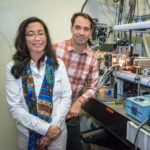The projects of 21 Biosciences Area scientists and engineers received funding through the FY24 Laboratory Directed Research and Development (LDRD) program.
Hura, Tsutakawa named Science Deputy, Structural Biology Department Head
Molecular Biophysics and Integrated Bioimaging (MBIB) Division Director Junko Yano has announced that staff scientists Greg Hura and Susan Tsutakawa have officially assumed the roles of MBIB Science Deputy and Head of the Structural Biology Department, respectively. They have been serving in these positions on an interim basis since August 2021.
How Algae Use Memory to Adapt to Sudden Changes in Sunlight
A new study co-led by Graham Fleming, a senior faculty scientist in the Molecular Biophysics and Integrated Bioimaging (MBIB) Division, and Krishna Niyogi, a faculty scientist in MBIB, reveals the precise molecular machinery that underpins photoprotective memory in green algae. The results may help scientists develop more productive plants and improve crop yields.
Congratulations to Biosciences Area Director’s Award Recipients
Several Biosciences Area personnel are among the 2023 Berkeley Lab Director’s Awards honorees. This annual program recognizes outstanding contributions by employees to all facets of Lab activities. A complete list of winners can be found here. The 2023 Director’s Achievement Awards ceremony will take place on November 8 from 3:00 – 4:15 PM in the Building 50 Auditorium and virtually on streaming.lbl.gov.
Biosciences Researchers Launching Biopreparedness Projects
Two scientists in the Area, Greg Hura and Vivek Mutalik, are heading up research projects that are part of the Department of Energy’s Biopreparedness Research Virtual Environment (BRaVE) initiative. Yasuo Yoshikuni, a scientist at the Joint Genome Institute, is part of a third project that is being led by Brookhaven National Laboratory. These projects will leverage bioimaging expertise to develop better therapies and vaccines for viruses, develop a high-throughput platform to rapidly design countermeasures to drug-resistant pathogens, and unlock the molecular basis of plant-pathogen interactions to create resilient bioenergy crops.
- « Previous Page
- 1
- 2
- 3
- 4
- 5
- …
- 75
- Next Page »
Was this page useful?








